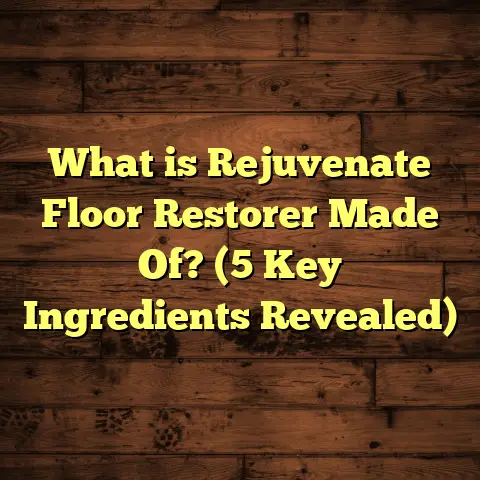What is a Floor Leveler? (5 Benefits for a Flawless Surface)
Upgrading your home’s flooring can seriously change how your space feels and functions. When I decided to redo the floors in my living room, I was excited but also overwhelmed by the prep work involved. One thing quickly became clear: a flawless surface is the key to a long-lasting, beautiful floor. That’s where a floor leveler plays a vital role.
What Is a Floor Leveler?
A floor leveler is a material designed to create an even, smooth base on a subfloor before installing your final flooring. It’s usually a self-leveling compound—a type of liquid cement or gypsum-based mix—that you pour onto the floor. This material flows across the surface, filling dips, cracks, and rough patches, then hardens to form a flat surface ready for tile, hardwood, vinyl, or any other flooring.
I remember early in my career stepping into a project where the concrete slab had dips of nearly half an inch in some places. Trying to install tile directly over that would have been a disaster—tiles would crack or grout would fail. Pouring a floor leveler transformed that uneven mess into a smooth canvas in just a few hours.
Why does this matter? Because even tiny irregularities in the subfloor can cause your finished floor to look off or fail prematurely. So, floor levelers are not just about looks—they’re about protecting your investment.
How Does a Floor Leveler Work?
Essentially, you prep the surface by cleaning and priming it. Then you mix the leveler compound to the right consistency and pour it over the low spots. Because it’s self-leveling, the compound spreads out evenly under its own weight. After drying—usually several hours or overnight—you get a perfectly flat surface ready for flooring installation.
The compound’s thickness can vary based on how uneven your floor is. For minor imperfections, a thin pour of about 1/8 inch might do the trick. For deeper holes or dips, you might need multiple layers or thicker applications.
Why Use a Floor Leveler? Five Key Benefits for Your Project
I want to share five concrete reasons why I strongly recommend using a floor leveler whenever you start a flooring project.
1. Creates an Even Surface for Perfect Flooring Installation
A flat foundation is essential for any flooring material, whether it’s hardwood, tile, carpet, or vinyl planks. Uneven floors can cause materials to warp, buckle, or crack.
During one job, I had to install engineered hardwood over an old plywood subfloor that was uneven by nearly 3/8 inch in some spots. Without leveling first, the planks would have shifted and separated over time. Applying a self-leveling compound created a uniform surface and prevented future issues.
Industry standards typically require subfloors to be flat within 3/16 inch over 10 feet for hardwood and laminate installations. Floor levelers help meet or exceed these specs.
2. Speeds Up Flooring Installation and Saves Labor Costs
When your subfloor is uneven, installers spend extra time adjusting planks or tiles to fit gaps or bumps. This can double installation time in some cases.
I once worked on a project where the client skipped floor leveling to save money upfront but ended up paying more for labor because installers had to cut and shim boards continuously.
Using a floor leveler reduces the need for these adjustments, making installation smoother and faster. That means you save money on labor and get your project done sooner.
3. Extends Flooring Life by Preventing Damage and Wear
Uneven subfloors put stress on flooring materials during daily use. For example:
- Floating floors may separate at joints or buckle.
- Tiles can crack due to uneven pressure points.
- Adhesives may fail if the surface isn’t stable or flat.
According to data from flooring manufacturers and construction studies, floors installed on properly leveled subfloors can last 20-30% longer than those installed over uneven surfaces.
That longevity directly translates into cost savings since you won’t need repairs or replacement as soon.
4. Meets Manufacturer Warranty Requirements
Most flooring manufacturers include flatness requirements as part of their warranty terms. Ignoring these requirements voids your warranty.
Before every project, I review product warranties carefully and recommend floor leveling compounds whenever specs call for it. This protects both me as the installer and the homeowner.
Skipping leveling may seem like an easy way to cut corners but it risks losing valuable coverage down the line if something goes wrong.
5. Provides Versatility for Many Flooring Types
Floor levelers work with nearly every type of flooring:
- Tile: Tiles require very flat surfaces to avoid cracking.
- Hardwood & Laminate: Need uniform support to prevent warping.
- Vinyl Planks: Adhesives bond better on smooth surfaces.
- Carpet: Helps avoid bumps showing through padding.
Once I started using floor levelers regularly, I found it easier to switch between different flooring types without worrying about subfloor conditions.
Getting Into the Details: The Science Behind Floor Levelers
Why do these compounds work so well? It’s all about chemistry and physics.
Self-leveling compounds are mixtures of cement (or gypsum), fine sand or fillers, water, and sometimes polymers (special additives). Polymers improve adhesion and flexibility.
When mixed with water, these compounds become fluid enough to flow without assistance but thick enough not to run off edges immediately. Surface tension helps them spread evenly until they settle flat.
Once dry, the compounds cure into solid layers with compressive strength comparable to concrete—strong enough to support floors and foot traffic without cracking under normal conditions.
Typical Application Thicknesses
- Feather edging (very thin): Less than 1/8 inch for smoothing minor imperfections.
- Standard thickness: Between 1/8 and 1/2 inch for most leveling jobs.
- Deep fills: Over 1/2 inch may require special mixes or multiple layers.
Using too thick of a layer at once can cause cracking as it dries—so it’s important to follow manufacturer guidelines.
How I Prepare Floors Before Leveling: Tips From My Work Site
Preparation is everything when working with leveling compounds. Here’s what I always do:
- Clean Thoroughly: Remove all dust, grease, oils, paint, or loose debris that could prevent bonding.
- Repair Major Damage: Fill holes or cracks larger than 1/4 inch with patching compound or epoxy.
- Prime the Surface: Use primer recommended by the leveling product maker; it helps adhesion and prevents bubbles.
- Control Moisture: Check moisture levels in concrete slabs using meters; excess moisture can ruin curing.
- Tape Off Adjacent Areas: Protect walls and doorways from spills using painter’s tape and plastic sheeting.
Skipping any of these steps often leads to problems like bubbling, cracking, or peeling after drying.
My Most Challenging Floor Leveling Project (And What I Learned)
One project stands out as both difficult and rewarding. The home was built in the 1920s with old wooden subfloors that had warped significantly over decades—some sections had dips over half an inch!
Replacing all the wood was not an option due to budget and time constraints. So I decided to:
- Repair rotten boards with plywood patches.
- Sand down high spots carefully.
- Use multiple layers of polymer-modified self-leveler for depth and flexibility.
It took two days of prep and application but resulted in a surprisingly sturdy and flat surface suitable for installing engineered hardwood.
The client was thrilled with how smooth it felt underfoot compared to the old squeaky floorboards.
This taught me that patience in preparation pays off big time—don’t rush leveling even if it means more upfront work.
The Cost Factor: How FloorTally Helps Me Plan Projects
Estimating costs accurately has been one of my biggest headaches over the years—especially when working on remodeling projects with tight budgets.
I’ve started relying on FloorTally for cost estimation because it consolidates labor rates, material costs (including floor leveling compounds), waste factors, and installation specifics into one easy-to-use platform.
For example:
- I enter project dimensions.
- Select materials (like cement-based leveler).
- Input local labor costs.
- Add waste percentages (usually around 5-10% for leveling compound).
FloorTally then calculates detailed estimates which help me present realistic budgets to clients from day one.
This has saved me from common pitfalls like underestimating material needs or overlooking labor charges related to leveling prep work.
Case Study: Transforming a Basement Floor With Leveling Compound
A client asked me to renovate their basement with luxury vinyl planks (LVP). The original concrete slab was uneven due to settling over time—some low spots measured nearly 1/4 inch deep.
I started by testing moisture levels—basements tend to be damp—and used a moisture barrier primer before applying a gypsum-based self-leveler designed for interiors with moderate humidity.
After pouring the compound over two sessions (due to depth), we achieved a flat surface within tolerance limits required by the LVP manufacturer.
The planks were installed smoothly with no warping or gaps after six months of use—the client was very happy with how professional everything looked.
Common Questions About Floor Levelers
Can I apply floor leveler myself?
Definitely yes! Many products are DIY-friendly with simple mixing instructions and quick drying times. However:
- You need proper prep skills.
- Must use recommended primers.
- Should work quickly after mixing since some compounds set fast.
If you’re unsure about subfloor conditions or large uneven areas, consulting pros is wise.
How long does it take for a floor leveler to dry?
Drying depends on compound type and thickness but generally:
- Thin layers (under 1/8 inch) dry in 2-4 hours.
- Standard layers dry overnight (6-12 hours).
- Thick layers may take 24 hours or more.
Always follow product instructions before installing flooring on top.
What if my floor has major cracks?
Floor levelers aren’t structural repair materials. Large cracks should be repaired first using patching compounds or epoxy fillers designed for subfloor repair before leveling.
Are floor levelers waterproof?
Most cement-based ones are moisture resistant but not waterproof. For wet areas like bathrooms or basements prone to water seepage, use moisture membranes beneath leveling compounds as recommended.
Expert Tips For Using Floor Levelers Like A Pro
- Always mix small batches you can pour quickly.
- Use long-handled squeegees or trowels to help spread if needed.
- Work in well-ventilated areas due to dust during mixing.
- Wear protective gear: gloves, mask, goggles.
- Don’t skip priming—it makes all the difference in bonding.
- Avoid applying in temperatures below 50°F (10°C) unless product specs allow.
I keep these tips handy on every job site; they’ve helped me avoid many common mistakes.
Trending Innovations in Floor Levelers
The flooring industry evolves constantly. Here are some newer developments I find interesting:
- Rapid Cure Formulas: Set within minutes allowing same-day flooring installation.
- Eco-Friendly Compositions: Reduced VOC emissions and safer for indoor air quality.
- Flexible Compounds: Better accommodate slight subfloor movements without cracking.
- Self-Healing Materials: Emerging tech uses polymers that repair minor cracks over time.
Staying updated on these trends helps me offer better options to clients who want both performance and sustainability.
Final Words From My Experience
A great floor looks effortless but takes solid groundwork behind the scenes—and floor leveling is one of those foundational steps you don’t want to skip.
If you’ve ever dealt with uneven floors causing headaches during installation or afterward—whether warping planks or cracked tiles—you know how frustrating it can be. Using a quality floor leveler saves time, money, and stress in projects large or small.
Have you thought about leveling your subfloor but feel unsure about how? Or maybe you’re curious how much it costs? Just ask! I’m always happy to share what I’ve learned after years of hands-on experience helping people make their floors perfect underfoot.
Remember: good floors come from great foundations. And that starts with getting your surface flat—every single time.





